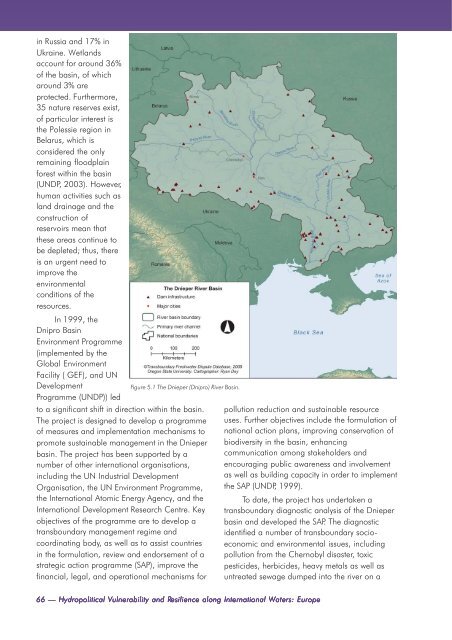Europe - UNEP
Europe - UNEP
Europe - UNEP
Create successful ePaper yourself
Turn your PDF publications into a flip-book with our unique Google optimized e-Paper software.
in Russia and 17% in<br />
Ukraine. Wetlands<br />
account for around 36%<br />
of the basin, of which<br />
around 3% are<br />
protected. Furthermore,<br />
35 nature reserves exist,<br />
of particular interest is<br />
the Polessie region in<br />
Belarus, which is<br />
considered the only<br />
remaining floodplain<br />
forest within the basin<br />
(UNDP, 2003). However,<br />
human activities such as<br />
land drainage and the<br />
construction of<br />
reservoirs mean that<br />
these areas continue to<br />
be depleted; thus, there<br />
is an urgent need to<br />
improve the<br />
environmental<br />
conditions of the<br />
resources.<br />
In 1999, the<br />
Dnipro Basin<br />
Environment Programme<br />
(implemented by the<br />
Global Environment<br />
Facility ( GEF), and UN<br />
Development<br />
Programme (UNDP)) led<br />
to a significant shift in direction within the basin.<br />
The project is designed to develop a programme<br />
of measures and implementation mechanisms to<br />
promote sustainable management in the Dnieper<br />
basin. The project has been supported by a<br />
number of other international organisations,<br />
including the UN Industrial Development<br />
Organisation, the UN Environment Programme,<br />
the International Atomic Energy Agency, and the<br />
International Development Research Centre. Key<br />
objectives of the programme are to develop a<br />
transboundary management regime and<br />
coordinating body, as well as to assist countries<br />
in the formulation, review and endorsement of a<br />
strategic action programme (SAP), improve the<br />
financial, legal, and operational mechanisms for<br />
Figure 5.1 The Dnieper (Dnipro) River Basin.<br />
pollution reduction and sustainable resource<br />
uses. Further objectives include the formulation of<br />
national action plans, improving conservation of<br />
biodiversity in the basin, enhancing<br />
communication among stakeholders and<br />
encouraging public awareness and involvement<br />
as well as building capacity in order to implement<br />
the SAP (UNDP, 1999).<br />
To date, the project has undertaken a<br />
transboundary diagnostic analysis of the Dnieper<br />
basin and developed the SAP. The diagnostic<br />
identified a number of transboundary socioeconomic<br />
and environmental issues, including<br />
pollution from the Chernobyl disaster, toxic<br />
pesticides, herbicides, heavy metals as well as<br />
untreated sewage dumped into the river on a<br />
66 — Hydropolitical Vulnerability and Resilience along International Waters: <strong>Europe</strong>
















